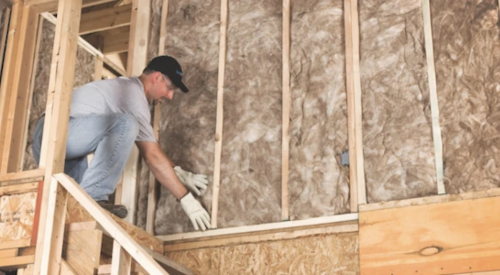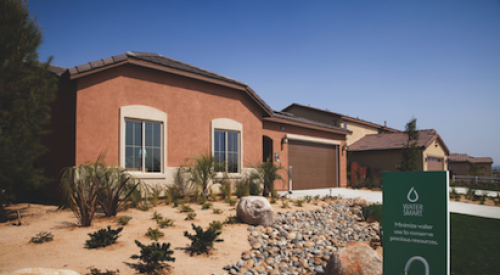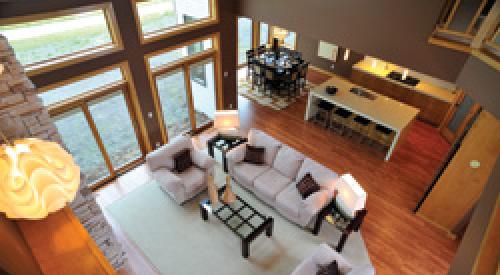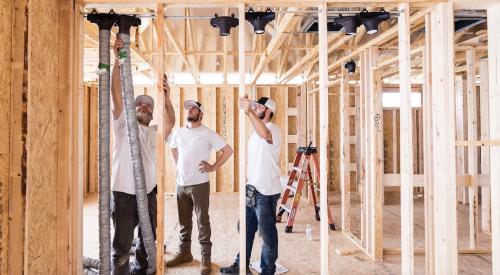The truth about Pulte Homes’ systems engineered housing - homes that are 30 to 50 percent more energy efficient than model energy codes require - is that they do cost more to build. But since Pulte began its initiative in its West Group nine years ago, this Giant builder has learned an important truth: the cost is worth it, both to the company and to the home buyer.
Pulte’s commitment to energy efficiency was born, in fact, because consumers consistently ranked it of highest importance to them, along with builder reputation and design. "We felt we could leverage innovative building techniques into our homes and bolster our performance in all three areas," said Alan Kennedy, director of construction, Tucson Division of Pulte Homes. The Tucson division is the Builder of the Year winner in the 2001 Energy Value Housing Awards, an annual award given by the National Association of Home Builders’ Research Center.
"Pulte Homes is pushing the production building envelope," explains Jeannie Leggett Sikora, program coordinator for the NAHBRC. "It’s commitment to quality construction and resource efficiency is evident in all of its business practices. Pulte partners with contractors and suppliers to streamline production processes and reduce cost."
| Pulte uses a third-party to test and certify the energy efficiency of every home.
|
"Pulte has a long history of providing homes of value and quality to our customers," said Alan Laing, vice president/E-Business, supply chain and customer satisfaction for Pulte Homes. "Essential to our strategy is a commitment to energy efficiency and quality construction. Homeowners are embracing these energy-saving features in record numbers."
Pulte Homes/Tucson was also recognized for its Wind Dancer model, an 1838-square foot home in its Spanish Trails community. Wind Dancer is one of more than 1750 systems-engineered units the West Group closed on in 2000, says West Group Vice President Randy Folts - more than half of the 3500 units (at an average price of $200,000) built in the tri-state area of Arizona, Nevada and California.
Efficiency Partners
Folts and Kennedy attribute the company’s success to partnerships Pulte cultivated early in its energy-efficiency campaign. The Department of Energy’s Building America program launched in 1992 was first on the scene, selecting Building Science Consortium to work with Pulte’s Southwest region. In 1995, BSC began testing innovative building materials and techniques in Pulte’s Las Vegas division. The result was a building-systems approach that is now practiced by all divisions throughout the West.
| Alan Kennedy, director of construction/Tucson division, says partnerships play an important role in building and selling energy efficient housing.
|
Among other things, BSC tested surface temperatures of roof deck because unvented attic space was new to the industry then, and there was concern about the temperature of the plywood at the roof deck and the moisture in the attic space. "Our work with Building Science Consortium established our program, and today they assess our floor plans and specifications for performance before we build or offer our homes for sale," Kennedy explains. "They administer testing results and regularly consult with us about design, products and training."
Southwest Gas is another partner in the company’s effort to provide energy efficient homes, offering energy specifications that if met, provide additional marketing benefits. Southwest Gas’ Energy Advantage Plus homes, for example, use 30 percent less energy than the 1995 Model Energy Code for Tucson.
Another partner is GreenStone/ Louisiana Pacific and its Engineered for Lifee program. They produce the Cocoone insulation system that Pulte uses, which includes insulation on the top chord of the truss and a moistened cellulose insulation in the walls.
| 28 x 68 faming on Pulte Homes’ units in Tucson allows for more insulation in the walls and greater energy efficiency throughout. Blown in cellulose insulation is standard.
|
It also has been instrumental in training Pulte employees and trade contractors, as well as underwriting the builder’s heating and cooling guarantees to customers. "Engineered for Life" in cooperation with Building Science Consortium, outlines prescriptive building techniques and specifications for achieving the results that we want our customers to experience," according to Kennedy.
"Engineered for Lifee means together, we guarantee to each customer average monthly heating and cooling bills (based on current utility rates), and comfort - rooms within 3 degrees of one another with regulated introduced outdoor fresh air."
Kennedy notes that local building officials were initially somewhat skeptical of Pulte’s new techniques, particularly when it came to unvented attic space. Code said attic spaces must be vented, and officials worried about condensation build-up.
"We have a sealed combustion furnace placed in the attic with a PVC-vent through the roof and that concerned them," Kennedy says. "We brought BSC principal Joseph Lstiburek in for conversations with building officials, answering their concerns and explaining results for homes in the Las Vegas market. DOE also endorses our building approach. We have had the support when questioned about our techniques."
A Question of Cost
As for the cost increase, energy efficiency can be a hard sell at first - for both builders and buyers, Folts admits. Folts, who preceded Kennedy in Tucson and was in on the groundbreaking energy effort says one of the biggest challenges was convincing Pulte’s own marketing department that the paybacks of the energy-efficiency program would outweigh the costs.
"Initially there was an increase of $1200 to $1500 over the cost to build a conventional 1500 to 1800 square foot energy-efficient house, " Folts says. Today that figure has dropped to $700 to $1000 per house.
Pulte has saved money in other ways too, particularly in reduced warranty service calls. "In homes not built with these principles, comfort complaints are common. With the building science systems, we don’t have these problems," Folts said.
Selling Value
While Pulte’s active adult buyer category has never questioned the value of energy efficiency, it’s a tougher sale with younger buyers. "Energy efficiency alone is a hard sale: people want to save the environment and do the right thing. But it’s a different story when we ask them to open their wallet for it. For the same $1200 buyers would rather have an additional ceramic tile floor, a bay window or patio cover, things they can see. So rather than just selling the energy efficient home, we sell the systems-engineered home, one that has lower operating costs, is more durable, addresses health and safety and has a higher resale value."
Kennedy notes that while elements like low-e windows and systems-engineered insulation techniques cost more than conventional materials and installation, Pulte realizes savings from using less framing material and from reduced air-conditioning load.
"Our costs are slightly higher even after reductions in lumber and air conditioning. From our perspective the incremental cost that consumers see in the sales price for our homes is more than offset by their utility bills," Kennedy says. "It costs our customers roughly $800 more to have a energy-efficient home that comes with a two-year guarantee on heating and cooling bills. The payback on energy savings is worth every penny."
For example, financing $800 at 8% for 30 years costs roughly $6 per month. Pulte’s Wind Dancer floor plan has a monthly averaged heating and cooling guarantee of $47 per month. At Model Energy Code, the expected typical averaged monthly heating/cooling bill would be approximately $79 per month. The annualized savings is $384 and payback on the up front coast occurs in just over two years.
"Looking at cost without evaluating value is always a mistake. We choose constant improvement, and sometimes incremental costs get added, but at the same time, value increases to a greater level. It would be a mistake to not utilize what we know and to not provide these benefits to our consumers.
"Builders have to take more of a leadership role in energy conservation. As utility prices rise, and we experience more brownouts and blackouts as we have in the Western United States recently, new home buyers are going to demand that builders produce more energy-efficient housing. It will become a defacto quality statement."
Also See












